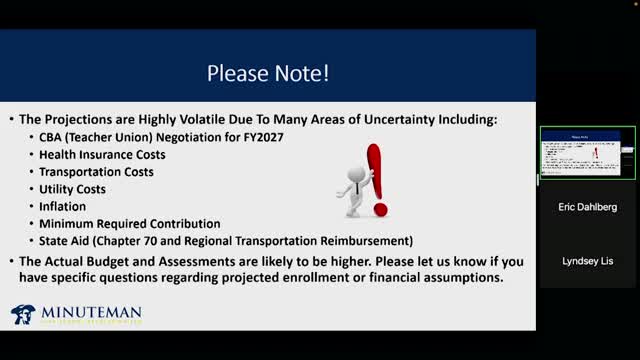Budget Projections Spark Debate Over Student Enrollment Trends
October 26, 2024 | Concord Public Schools/Concord-Carlisle Regional District, School Boards, Massachusetts
This article was created by AI summarizing key points discussed. AI makes mistakes, so for full details and context, please refer to the video of the full meeting. Please report any errors so we can fix them. Report an error »

During a recent government meeting, officials discussed the complexities of budgeting for a vocational regional technical school, emphasizing the challenges posed by fluctuating student enrollment. The school’s budget is closely tied to the number of students, making projections difficult compared to traditional public schools, which can anticipate enrollment based on census data.
The administration presented a three-year projected budget, highlighting a 3% operating increase assumption, influenced by current inflation rates. They noted that while the number of students has been increasing—growing from 25 to 41 since 2021—this growth brings financial implications, as the budget is directly correlated to student enrollment.
Officials provided insights into historical budget trends and assessments per pupil, indicating that while operating expenses have risen, the per pupil assessment has shown variability. This fluctuation is attributed to various offsetting costs, including out-of-district tuition and capital assessments, which can impact the overall financial picture.
The meeting also addressed the enrollment dynamics, revealing that the school accepted a few non-member town students in the latest freshman class, which has implications for revenue from out-of-district tuition. As the trend shifts towards more member town students, officials warned that this could lead to higher assessments in the absence of offsetting revenues.
The new superintendent, who began in July, shared his focus on effective entry and direction-setting for the district. He is actively engaging with both district personnel and member towns to identify strengths and challenges, as well as opportunities for improvement in policies and practices.
Overall, the discussions underscored the importance of careful financial planning and the need for ongoing assessment of enrollment trends to ensure the sustainability of the vocational education program.
The administration presented a three-year projected budget, highlighting a 3% operating increase assumption, influenced by current inflation rates. They noted that while the number of students has been increasing—growing from 25 to 41 since 2021—this growth brings financial implications, as the budget is directly correlated to student enrollment.
Officials provided insights into historical budget trends and assessments per pupil, indicating that while operating expenses have risen, the per pupil assessment has shown variability. This fluctuation is attributed to various offsetting costs, including out-of-district tuition and capital assessments, which can impact the overall financial picture.
The meeting also addressed the enrollment dynamics, revealing that the school accepted a few non-member town students in the latest freshman class, which has implications for revenue from out-of-district tuition. As the trend shifts towards more member town students, officials warned that this could lead to higher assessments in the absence of offsetting revenues.
The new superintendent, who began in July, shared his focus on effective entry and direction-setting for the district. He is actively engaging with both district personnel and member towns to identify strengths and challenges, as well as opportunities for improvement in policies and practices.
Overall, the discussions underscored the importance of careful financial planning and the need for ongoing assessment of enrollment trends to ensure the sustainability of the vocational education program.
View full meeting
This article is based on a recent meeting—watch the full video and explore the complete transcript for deeper insights into the discussion.
View full meeting
